

| Invertebrate news 2016 |
| Insect and Arachnid news and sightings from around Nottinghamshire |
| A second Nottinghamshire record of
the Centipede Geophilus electricus Geophilus electricus is a rare Centipede in Nottinghamshire and for the best part of 50 years the county's only previously known record held by the British Myriapod and Isopod Group, was from Bingham in 1968. However, Geophilus electricus was recently found (November 2016) at the Nottinghamshire Wildlife Trust's Attenborough NR by Tim Sexton, continung the wealth of exciting finds Tim has single-handedly made over the past year or so. Geophilus electricus is thought to be one species with the ability to produce bioluminescence and glow bodily, although at the moment, we are aware of bioluminescence only being confirmed in Geophilus easoni after we carried out our own fieldwork in 2013. |
||
| Attenborough
NR provides another new Lacebug for the county Tim Sexton has yet again provided Nottinghamshire with another new Lacebug when Dictyonota fuliginosa was found at the Nottinghamshire Wildlife Trust's Attenborough Nature Reserve in early October 2016. The specimen was beaten off Broom (Cytisus scoparius) by Tim, who has single handedly almost doubled the county Tingidae list within the space of two years. Dictyonota fuliginosa is found locally in southern and eastern counties of the UK, generally regarded as favouring old Broom bushes with plenty of seed pods. However Tim reported just the opposite in this case, beating his specimen from a small bush with very few seed pods on it. |
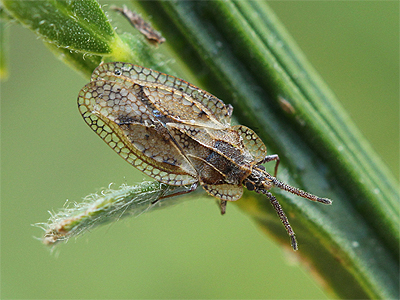 |
|
| Steatoda nobilis (the
Noble False Widow) found
at a second Nottinghamshire site Following on from Nottinghamshire's first ever record of the Noble False Widow at Attenborough NR in September, the spider has now been found at a second site in the north of the county. On September 30th, we visited the Dukeries garden centre between Mansfield and Worksop. Garden centres often provide us with some interesting invertebrates, but we were not expecting to find Steatoda nobilis. Found initially by their webs and suspecting something interesting on the strength of the web, we soon potted up a mature male and an immature female, but a larger female eluded capture by quickly dropping out of her retreat and was lost. The webs were constructed on some outdoor display stands and there is obviously a healthy population around the site. |
||
| Armadillidium
nasatum found
at Southwell Following a visit to the impressive Southwell Minster towards the end of September, we called in at the nearby Southwell Garden Centre. We hoped that after visiting several garden centres in search of what would be a new Woodlouse for the county, we would eventually be successful. We were soon lucky, when several specimens of Armadillidium nasatum were found under a small bag of sand lying on gravel. Armadillidium nasatum is rather patchily distributed across the UK south of the Humber. Fairly similar to Armadillidium vulgare, A. nasatum is surprisingly quick to move when disturbed. It is often recorded from old quarries, garden centres and brownfield sites and has been well recorded in neighbouring Leicestershire for years (Daws, J.) and should eventually turn up at more sites in Nottinghamshire. |
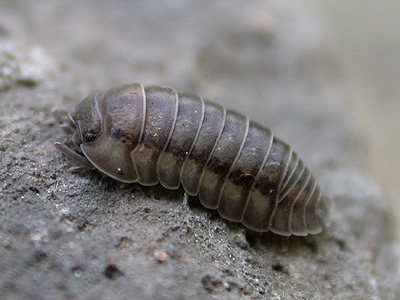 |
|
| Dahlica sp recorded
in Nottingham While visiting Nottingham City Hospital in late September, at least eight larval cases of a Dahlica sp were found on lichen covered coping stones on the road bridge at the junction of Hucknall Road and Valley Road. The cases were initially thought to be those of Dahlica triquetrella and some photographs were taken for examination later. All the cases appeared to have been recently active due to their exposed positions on the wall, but larvae were not seen. So we made a return visit a few days later, to collect a few cases for identification. The larvae appear to be those of Dahlica lichenella, which has not been previously recorded from the Nottingham area, but are to be bred through to confirm idenification. |
||
| Another Nottinghamshire site for
Dock Bug The impressively large Dock Bug (Coreus marginatus) is continuing to expand its range in the Nottingham area, with a healthy population being found on Valley Road, on a recreation area close to the City Hospital's Hucknall Road entrances. A widespread and common species in the south of the UK, it is currently known from just a handful of sites. Nottinghamshire's first record was thought to have been from Netherfield in 2012, but there is a record listed on the NBN Gateway for Nottingham University (recorder unknown) in 2007. It is currently known from along the Trent Valley in south-west Nottinghamshire, all of which are within close proximity to the City itself. The county's most recent record from a recreation ground on Valley Road close to Nottingham City Hospital, is the first record away from the Trent Valley. The nymphs and adults feed on Docks (Rumex sp) but they will occasionally wander on to other low vegetation. |
||
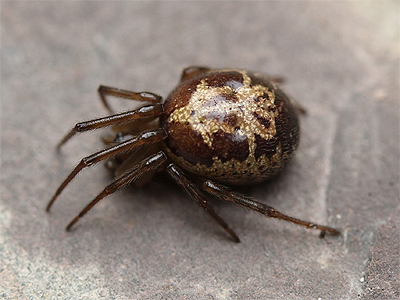 |
New to Nottinghamshire - the first
county record of Steatoda nobilis at
Attenborough Located in the very south-west of the county, Nottinghamshire Wildlife Trust's Attenborough Nature Reserve is certainly well placed to record invertebrates expanding their UK range northwards. But having someone like Tim Sexton helping to manage the site and who is enthusiastic about the wildlife the reserve attracts, is another bonus when it comes to recording the species few others bother to even look at. Tim's latest find is certainly his most notorious and of a species which most have heard of - if for totally the wrong reasons. Steatoda nobilis (the Noble False Widow) is usually found around the outside of buildings and houses, producing a scaffold web with a tubular retreat. |
| ................. | ||
| Being one of
the 'False Widow' Spiders, Steatoda nobilis has
often been incorrectly blamed by the TV and Press for a
number of reports of bites in the south of the country.
The vast majority of these reports are completely
unverified and although S. nobilis can bite if
provoked, it is unlikely ever to do so. Thanks to
incorrect reporting and sensationalising claims by the
Media, this Spider now has an unwarranted reputation with
the public. Over the past number of years S. nobilis has become increasingly established inland and further north, moving away from south coast sites, where it has been established and common since the late 1800's. There are odd records from the neighbouring counties of Leicestershire, Lincolnshire and Derbyshire, but it does not appear to have become established based on the lack of additional records. Our thanks go to Tim for allowing us to use the above photograph. |
||
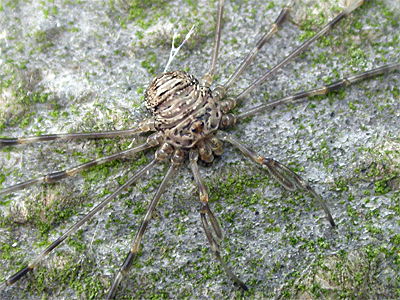 |
Potential
identification difficulties for the Harvestman Dicranopalpus
ramosus Originally of Mediterranean origin, Dicranopalpus ramosus (Simon, 1909) was once an easily identified Harvestman based on resting posture alone. But following the revalidation of Dicranopalpus caudatus (Dresco, 1948) as a seperate species, potential difficulties in identification have arisen and specimens should ideally be checked. Dicranopalpus ramosus first appeared in the UK in the 1950's and has since spread northwards to reach Scotland. It is now widespread in Nottinghamshire, where it is commonly found on the walls of buildings and is often beaten from the foliage of trees and bushes. It occurs in all habitat types. |
|
| ................. | ||
| Dicranopalpus caudatus was formerly considered a synonym of Dicranopalpus ramosus and has been recorded from the UK, although not for some 30 years now. The full pdf is available at the link below. | ||
| Andromeda
Lacebug new to
VC56 Unexpectedly found by Tim Sexton while sweep-netting marginal vegetation at the Nottinghamshire Wildlife Trust's Attenborough Nature Reserve, the Andromeda Lacebug (Stephanitis takeyai) is yet another remarkable first county record for Tim. It means that in the space of little more than a year, Tim has single-handedly added at least three new species of Lacebug (Tingidae) to the county list. The record is made even more unusual in that this Lacebug is usually found on Pieris and Rhododendron. There are few UK records of this Japanese species since it was first recorded in 1998. Our thanks go to Tim who kindly allowed us to use his photograph on the website. |
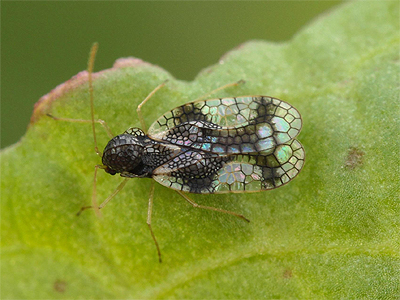 |
|
| Another site for Nigma walckenaeri in
Nottinghamshire The spread of this delightful spider in Nottinghamshire continues, after we found numerous adults and sub-adult Nigma walckenaeri on the leaves of Ivy and Elder at the entrance to Lambley Cemetery in late August. This spider is clearly much more widespread now than records currently indicate and it should be certainly be looked for wherever Ivy grows. Urban and suburban areas should especially be checked, but Nigma walckenaeri is by no means restricted to Ivy and can be found on any tree or shrub with leaves which allow a small sheet web to be constructed across its upper surface. |
||
| Azalea Leaf Miner
disovered as new to Nottinghamshire in Mansfield The Azalea Leaf Miner (Caloptilia azaleella) is an adventive species that has been spreading north throughout the UK. Its always been a species worth looking out for in urban gardens and parks and was recently found in a small Mansfield garden in early August 2016. Dave Budworth, the county micromoth recorder for Derbyshire and Nottinghamshire, confirmed that there had been no previous records from either county. The mines are distinctive. The larva initially mine the leaves and produce a blotch mine similar to thise produced by most Phyllonorycters, later forming a distinctive cone by rolling the leaf downwards from the tip. |
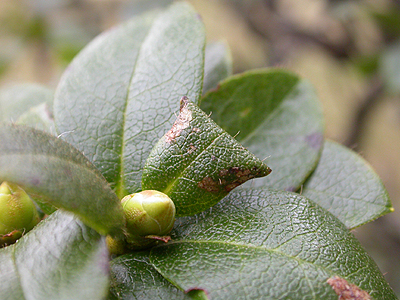 |
|
| Recent studies and observations of the bioluminesence produced by male Glow Worms (Lampyris noctiluca) in a captive environment | ||
| ................. | ||
| Bioluminescence produced by female
Glow Worms is a well known phenomenon and one which was
first scientifically described and written of many
centuries ago. Similarly, the bioluminescent glows produced by hunting larvae are equally well known among many Glow Worm enthusiasts, yet the bioluminesence produced by the male Glow Worm is another matter entirely and one which still proves difficult to convince people of. A few years ago, our good friend and colleague Martin Dale co-authored two research reports into larval bioluminesence, which we published in November 2015. Both Martin and ourselves were equally fascinated by the male Glow Worm's ability to glow. There is no doubt that male Glow Worms do indeed produce short-lived, characteristic glows (flashes) in flight, but proving it has always been difficult and it was a challenge recently taken up by Martin. |
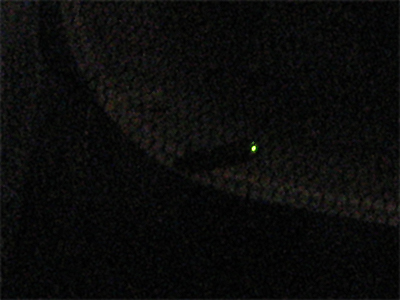 |
|
| ................. | ||
| Martin's first observational notes are available at the link (The bioluminescence of male Glow Worms) and he even managed to capture the male glow on several photographs. This may well be the first time that confirming evidence of bioluminescence produced by male Lampyris noctiluca has been published. | ||
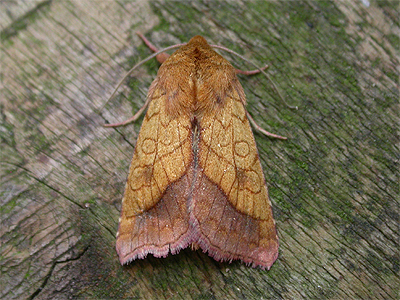 |
Bordered Sallow
and some other recent moth records 2016 continues to be a poor one for most moths and moth trappers, with many people hardly even running their traps this year, due to the weather. However, there have been a few notable records we know about. Bordered Sallow (Pyrrhia umbra) netted at dusk by Dave and Marlene Morton at Hills and Holes SSSI on June 25th 2016. Bordered Sallow has to be considered a rare moth in Nottinghamshire, as it currently has Grade 2 status and there seem to be no post-2000 records. Bohemannia pulverosella Leaf mines found at Rotary Wood near Edwinstowe (a section of former Colliery spoil heap) on June 26th 2016 where an abundance of Malus and other native shrubs and trees were planted in the late 1990's. |
|
| ................. | ||
| Coleophora limosipennella Uncommon and only recorded as being new to Nottinghamshire in 2007, when a larval case was found at Bunny (per Dave Budworth). There appear to have been no further records until we found three larval cases at different stages of development, on a small Elm growing along Peafield Lane near Market Warsop on June 2nd 2016. | ||
| Second county record of the
Centipede Cryptops anomalans Nottinghamshire has two of the UK's three species of Cryptops, following the county's first ever record of Cryptops anomalans at Worksop Priory by Keith and Belinda Lugg back in August 2015. After many return visits to the same site to survey for the Harvestman Leiobunum sp. A, we eventually found a second specimen of Cryptops anomalans on June 17th 2016, but unfortunately missing its rear legs. Cryptops anomalans is a larger species than Cryptops hortensis and when seen under the microscope, has the characteristic 'X' suture on the first thoracic tergite. |
||
| First
2016 records of Leiobunum
sp A A much earlier visit than normal was made to Worksop Priory, with the intention being to search for juvenile Leiobunum sp.A, a Harvestman new to the UK, which we had originally discovered on the wall of a Worksop house in 2009. It was to take us a further three years, before we found the species again, this time on the walls of Worksop Priory. It has progressively increased in numbers annually since and we make regular surveys of the Priory to monitor the population. Our visit this year was on June 17th, thinking that we would visit the Priory in order to search for juveniles. In the end, we found most of the 85 Leiobunum sp. A already as sub-adults, but we did record a few juveniles (shown right) with a 2.5mm body length. |
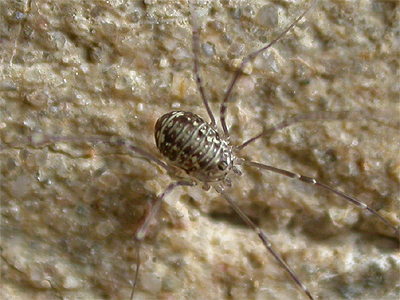 |
|
| ................. | ||
| There were no aggregations, but we did locate a loose group of eight sub-adults on the south wall of the Priory. None of the traditional aggregation areas on the Priory walls were occupied and most of the Leiobunum sp A found, were well scattered across the whole of the Priory's southern walls, usually in cracks and crevices, but often openly on the stonework in the manner of our native Leiobunum species. | ||
| Ocypus
ophthalmicus found in Mansfield An example of this distinctively coloured Rove Beetle, was surprisingly found crawling up the wall of a Mansfield day centre on 08/06/16 and looks to be the first county record since Sherwood Forest in 1912. Ocypus ophthalmicus is readily identifiable through its large size and distinctly turquoise coloured elytra, with the head and pronotum being slightly duller and is often more commonly known as the Blue Rove Beetle. |
||
| Huge
numbers of Diamond-back Moths arrive in UK and
Nottinghamshire Late May saw the biggest arrival of Diamond-back Moths to hit the southern and eastern UK coasts since 2006 and by June 1st, they were widespread across much of Nottinghamshire. We recorded our first of the year with two at Mansfield Crematorium on 01/06/16, immediately followed by one in our Market Warsop garden the same day. We ran the moth trap for an hour between 23:30 and 00:30h later that night and recorded 21 Diamond-back Moths (Plutella xylostella) despite the very windy conditions. |
||
| Psychoides
verhuella confirmed as new to VC56
(Nottinghamshire) We have recently received confirmation from Dave Budworth the microlepidoptera recorder for VC56, that Psychoides verhuella (Tineidae) has been added to the Nottinghamshire list. One of two very similar moths, the larvae of both mining the fronds of Fern spp, Psychoides verhuella (Tineidae) was previously unknown in Nottinghamshire until May 2016, when we found larval cases on Hartstongue Fern (Asplenium scolopendrium) growing along a former railway cutting at Arnold. The cases were originally thought to be those of Psychoides filicivora, which has been recorded from a nearby Mapperley garden and so a few were collected and reared through, producing adults in late May. |
||
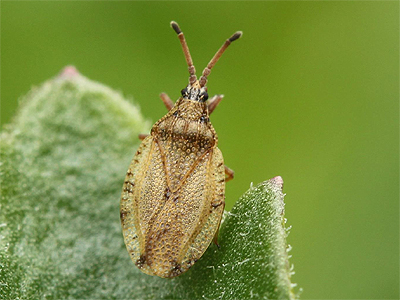 |
Catoplatus
fabricii at Attenborough NR Tim Sexton has recorded what is believed to be the first Nottinghamshire record of Catoplatus fabricii at Attenborough Nature Reserve. Sometimes known as the Ox-eye Daisy Lacebug, this Nationally notable species represents yet another notable record from this productive site. Tim and Sean Browne found just the single specimen, despite searching for several hours. Tim kindly allowed us to use his photographs on the website. Lacebugs are small insects, having sculptured wings and pronutum, producing the lace-like patterning, from which they derive their name. Catoplatus fabricii is generally scarce in southern parts of the UK, but has been recorded as far north as Yorkshire (per Flanagan, J). |
|
| Very
slow start to 2016 Glow Worm season January and February 2016, maintained the extremely mild Winter period and it looked set to be an incredibly early Spring this year. The promise of a very early start to our Glow Worm larval surveys, suddenly changed when the weather became much cooler. It was extremely similar to the situation a year earlier. The overnight temperatures were very low (although rarely with frost) and there were few invertebrates about generally. April continued the same climatically and it wasn't until the end of April that temperatures became warmer. Despite the cooler temperatures, we felt that conditions on many evenings, were mild enough to have encouraged some larval activity at Clipstone Old Quarter. Surveying drew a complete blank on five March dates and it wasn't until April 5th, that we recorded our first Glow Worm larva of 2016. |
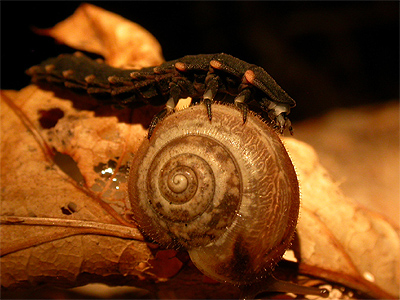 |
|
| ................. | ||
| April eventually produced just five larvae over 14 afternoon/evening surveys - our poorest total ever. We had our concerns by this point in time, as it seemed as though larval (and subsequently adult) numbers were going to be extremely low this year. | ||
| ................. | ||
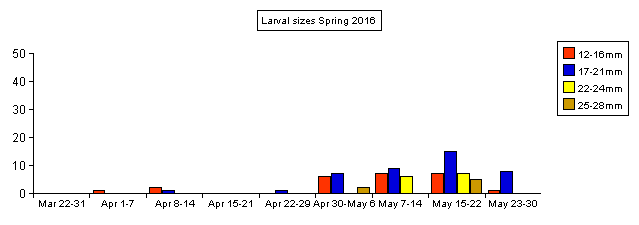 |
||
| May has seen an increase in the numbers of larvae found in Sections A, B, C and D of the survey site, but the current totals are usually those we record three or four weeks earlier. The following three graphs all show the larval sizes and totals found in 2016, in 2013 (our latest ever year for adult Glow Worms) and our earliest year for adult Glow Worms of 2011. The average larval size is also well below that normally expected for the period May 7th-14th. In previous years, average larval size has been recorded between 21.25mm and 23.25mm. It currently (14/05/16) stands at just 18.22mm. | ||
| Some
2016 Pseudoscorpion records The recording of Pseudoscorpions in Nottinghamshire has recently undergone a dramatic increase, with several naturalists now actively recording them. Consequently, there has been an increase in records, including the following from our own database. Chernes cimicoides - four under the bark of an ancient Oak at Clipstone Old Quarter on 03/01/16 and three under the bark of a fallen branch at Sherwood Forest CP on 15/05/16; Cheiridium museorum - a total of 16 recorded from the underside of a loose brick, in a derelict milking shed at Lambley on 09/01/16; Lamprochernes nodosus - a single found in a manure heap near Market Warsop on 23/04/16 and Allochernes wideri - singles found under tight-fitting Oak bark at Sherwood Forest CP on 05/05/16 and 15/05/16. |
||
| A
new spider for Nottinghamshire? On the late evening of May 1st 2016, we found a small, leggy spider in the bathroom sink at our home in Market Warsop. Being suspicious as to its likely identity, the Spider was potted and put in the fridge till the following morning, when it could be photographed. The resulting photographs allowed the Spider to be identified as Psilochorus simoni, often more commonly known as the Long-legged Cellar Spider. Originally of American origin, Psilochorus simoni first appeared in the UK back in the 1920's. It has remained scarce and there are considerably less than a hundred UK records (per Spider and Harvestman recording scheme). As far as we know, this is the first Nottinghamshire record. |
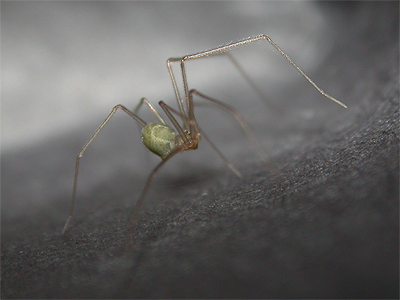 |
|
| Some
recent Nottinghamshire Millipedes Ophiodesmus albonanus is currently a rare Nottinghamshire Millipede, with the only previously known records coming from Bingham in 1969. On 21/04/16 we recorded three examples from underneath a small plank of wood in a suburban Mapperley garden, then found it two days later in our own Market Warsop garden. It is likely to have been previously under-recorded and careful searching of old suburban gardens, may reveal Ophiodesmus albonanus to be more widespread. After Boreoiulus tenuis was discovered new to the county at Kelham by Wil Heeney in 2015, there have been three subsequent records, which suggest that this has been an under-recorded Millipede in the county. In the first few months of 2016, it was found on the site of the former Rufford Colliery and along the Southwell Trail (Whiteley, D.) and by ourselves in a Mapperley garden. |
||
| Zora silvestris
recorded on Budby SF again We can report that a single specimen of Zora silvestris (RDB2) was found at a new location within the Sherwood Forest NNR, at the western-end of Budby South Forest on 20/03/16. Zora silvestris is a spider of dry heathland areas containing stands of heather, and which has been recorded from only a handful of sites in the south and south-east of the UK. Available British Arachnological Society data, shows that the only confirmed post-1992 Zora silvestris records are all from Sherwood Forest, where it was first recorded by a BAS survey team as recently as 1978. Since then, further records have occurred sporadically since 1987. Virtually all records are from the Sherwood Forest Country Park area, until we found one during an invertebrate assemblage survey of Budby South Forest in July 2010. |
||
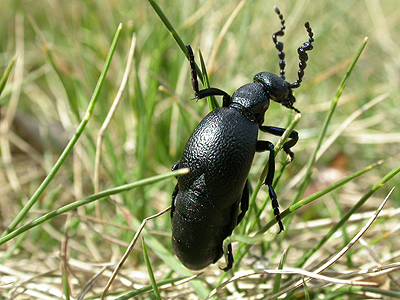 |
First Oil Beetles of 2016 on Budby Following the almost non-existant Winter, where at home we have recorded frosts on fewer than ten occasions and just an inch of snow for one day (to end of February) we made an earlier than normal first survey for Oil Beetles at Budby on 28/02/02. The first Oil Beetle (Meloe proscarabeus) was found almost immediately and a total of eight males were eventually recorded from the usual area, some of which had obviously been put for several days, due to their increased body weight. One of the total, did include a casualty of the Orienteering event, which was in progress at the time. Previous first dates have been March 7th 2015, March 3rd 2014, April 6th 2013 and March 23rd 2012, but the actual first emergence in each year, would have been earlier. |
|
| A new
site for Dahlica lichenella
Road bridges and stone walls are always worth checking for any the larval cases of Nottinghamshire's Psychidae moths, but it was surprising to find several cases of Dahlica lichenella near Sookholme in late February. Dahlica lichenella is currently known from just four other Nottinghamshire locations, all within the Market Warsop area. It used to be present in small numbers on the wall of the nearby Cemetery at Market Warsop, but appears to have died out from there and has not been recorded since 2013. |
||
| Another
new Millipede for Nottinghamshire Derek Whiteley reports the discovery of another new species of Millipede for the county, with Macrosternodesmus pallicola being found just inside the county border at Pleasley Vale. Derek also recorded a female Brachychaeteuma sp from the same site near St Chads Church, but was unable to determine the female specimen to species level, but the presence of three occeli mean it is either B. bagnalli or B. bradeae. |
||
| A new
Woodlouse for Nottinghamshire Derek Whiteley of the Sorby Natural History Society, reports finding Nottinghamshire's first records of the Woodlouse Trichoniscoides albidus in typical wetland habitat by the River Trent at Farndon on January 12th and then again a week later, at the Nottinghamshire Wildlife Trust's Farndon Willow Holt NR on January 19th 2016. Derek has also sent us a record of the Millipede Boreoiulus tenuis (another recent county first) from the site of the former Rufford Colliery at Rainworth. Boreoiulus tenuis was only added to the Nottinghamshire Millipede fauna last year, when found at Kelham by Wil Heeney on November 23rd 2015. |
||
| Over a century wait for further
records of two Nottinghamshire Woodlice Recent searches have produced records of two Woodlice, both of which had not been recorded in Nottinghamshire for over 100 years. Nationally described as rare, Porcellio dilatatus is typically a Woodlouse of synanthropic sites and is often found on or around farms. The county's only known record, was from a Chilwell greenhouse in the early 1900's and there were no subsequent records until we found it present in an old milking shed at a Lambley farm in January 2016. Despite seemingly being so rare in the county, it is likely to be present at other Nottinghamshire farms. |
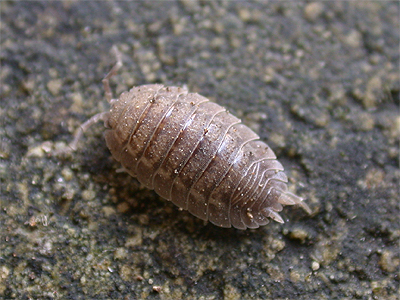 |
|
| ..... | ||
| Porcellionides pruinosus is a much more common and well distributed Woodlouse over most of the UK. Despite the previous lack of recent county records, it was always considered likely to be encountered within the manure heaps of most Nottinghamshire farms. One found in a manure heap at Brackenhurst near Southwell (Heeney, W. and Skinner, M. . Lugg, K. and Lugg, B.) in November 2015, was the county's first record in over a century and there have been other recent records from Tug Bridge Farm near Eakring in December 2015 and Lambley in January 2016. | ||
| Brachychaeteuma
is a Nottinghamshire first None of the UK's three species of Brachychaeteuma Millipedes have ever been recorded before in Nottinghamshire, so the record of this Brachychaeteuma from an Attenborough garden in early January 2016, is certainly representative of what species are waiting to be discovered, even within the confines of an urban garden. Unfortunately, two of the three UK Brachychaeteuma are extremely difficult to determine to species level and require an adult male to do so. Even then, there is great variability in the male gonopods. To make matters slightly worse for Tim Sexton (who found the specimen and sent us the photograph for inclusion) it was a female and so remains as Brachychaeteuma sp, but is either B. bagnalli or possibly B. bradeae. |
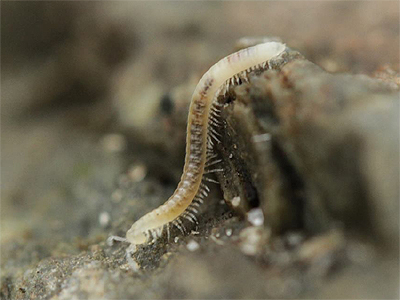 |
|